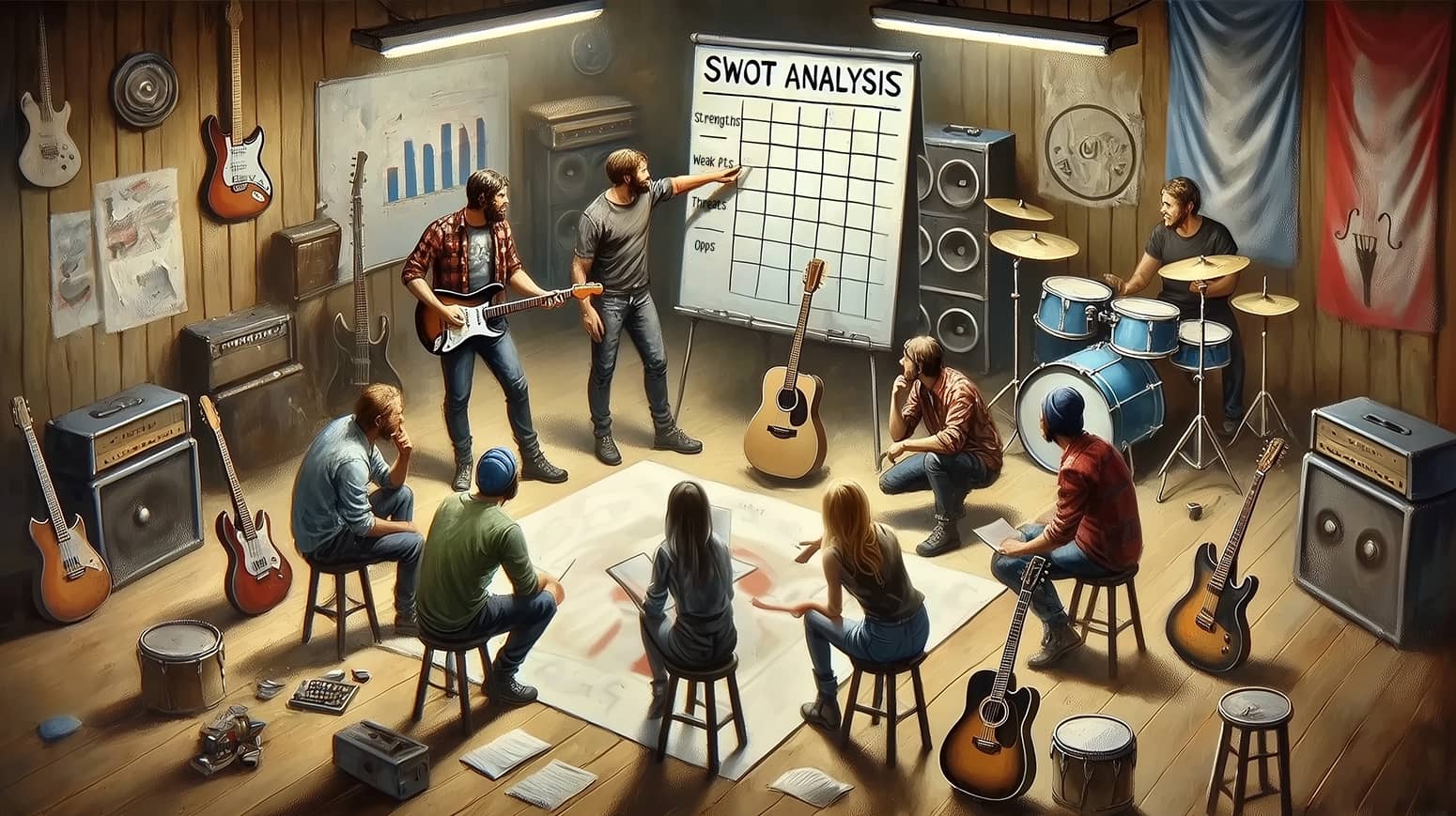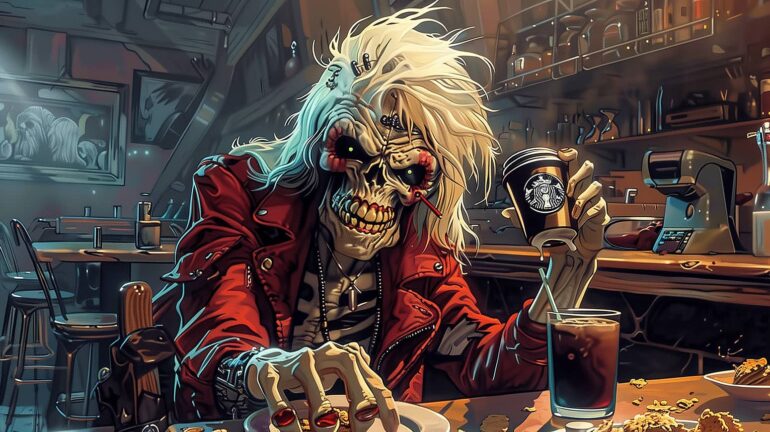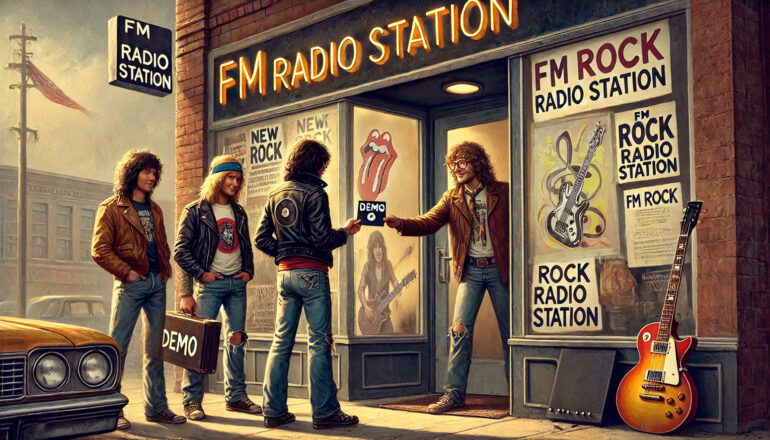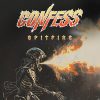We Tune You Up
Listeners:
Top listeners:
00:00
00:00
chevron_left
-
 play_arrow
play_arrow
WTYU.rocks We Tune You Up

share
close
How a Simple Strategy Can Help Your Band Find Its Identity, Strengthen Its Weaknesses, and Rock the Competition
Kevin McElroy
Editor, Tune Up Magazine
I’ve been at this game for a long time—working in the same industry for decades. It’s easy to get jaded, thinking I’ve seen it all. And it’s true—there are a lot of repeating patterns in this business. Problems that need to be addressed over and over again. That’s why I’ve been able to stick around so long—because these recurring issues are exactly what good marketers excel at solving. Even multi-billion-dollar businesses take a step back and run a SWOT analysis to assess where they are, chart a new course, and, hopefully, avoid the mistakes they made last time.
This article isn’t just about theory, though. It’s about you, your band, and using a tried-and-true process to get your act together, without falling into the traps that often come with being part of the rock-and-roll scene. Yes, rock and roll is about being anti-establishment, but don’t be fooled into thinking you can’t use established, professional practices like a SWOT analysis to help shape your band’s future. The trick is knowing how to use those tools without losing that edge.
A SWOT analysis might sound like corporate jargon, but it’s a business tool that can help you make sense of your band’s identity, identify what’s holding you back, and chart a course for growth. No matter if you’re just starting out or already an established act, it’s a crucial process that can keep things fresh and help you move forward. Even veteran bands can sometimes forget to check in with themselves—sometimes you need that extra reminder of the simple truths that keep things running smoothly.
What Is a SWOT Analysis?
A SWOT analysis is about taking stock of where your band stands, identifying the good and the bad, and figuring out how to leverage what works while addressing what needs improvement. It’s about finding the gaps and aligning yourself to move forward. Here’s the breakdown:
- Strengths: What do you do well? Think about your music, your live performances, and how your stage presence stands out. Maybe you have a strong fan base, great songwriting, or a live show that gets people talking. This is your foundation—don’t overlook it.
- Weaknesses: Every band has them. What needs work? This could range from something as simple as a lack of a cohesive brand (hello, logo design) to more strategic weaknesses like inconsistent social media engagement. Some of these might not be sexy, but they need to be addressed—often with help from people who specialize in areas where you might not have the skills, like design or copywriting.
“You can’t improve what you don’t measure.” – Peter Drucker
A SWOT analysis gives you a way to measure where you are and identify where improvement is needed. Once you have the data, you can make real progress.
- Opportunities: Where can you grow? It might be a new venue in town, a collaboration with another band, or an up-and-coming podcast that’s perfect for getting your name out there. Opportunities come in many forms, and finding them requires you to think beyond the obvious.
- Threats: What could hold you back? Maybe there’s competition from other local bands, or you’re running up against venues that don’t support original music. Could there be changing tastes in the music scene? Identifying these threats helps you stay proactive instead of reactive.
Why an Outside Person Is Key
Now, I know that being in a band often feels like a family, and it can be tough to have outsiders tell you what to do. But this is where a professional marketing consultant, designer, or even a music industry person can help you see things with fresh eyes. You’ve probably been in the trenches long enough that you might have missed a few things. And that’s okay—no one is perfect.
This is especially true when it comes to things like developing a brand. Your band’s logo or website might be a little rough around the edges, but that doesn’t mean you’re doomed. It just means you need someone to look at it through a different lens, someone who can help you see how it can connect better with your fans—and potential fans.
I can tell you from experience that good marketing and branding—whether it’s a well-designed logo or a clear message—makes all the difference. This isn’t about changing who you are; it’s about communicating what you stand for in a way that resonates with your audience.
The Value of Good Copywriting and Logo Design
Let’s talk about something I’ve seen firsthand—how good copywriting and a strong logo can actually help sell your band. When you’re just starting out, you might think that your music will speak for itself. And while that’s true to an extent, the way you present your band to the world can be just as important.
It took me years to realize that as a designer, a SWOT analysis wasn’t just some theoretical exercise—it was a game-changer for me. Early in my career, I was going off what people said about creative and messaging, but often it was based on their own subjective and jaded perspectives. After all, they’d been in the industry for decades, so surely they knew best. But what I realized is that when you’re too close to the work, you can’t see it objectively. You start to fall into complacency, relying on what worked last year or just repeating the same old formulas.
That’s why a SWOT analysis was such an eye-opener for me—it forced me to look at things through a different lens, without the baggage of personal ego or industry fatigue. Once I understood how to view creative decisions through the objective lens of a SWOT analysis, I was able to push back on decisions that weren’t aligned with the bigger picture. I could start speaking up with an informed perspective rather than just relying on subjective feelings or the “we’ve always done it this way” mentality. That shift made all the difference in my work and how I engaged with clients.
So when it comes to your band, you need the same mindset. You might not be a designer or a copywriter, but hiring or working with one can elevate the way you present yourself. A strong logo, cohesive visual identity, and clear messaging will speak volumes about your professionalism and help fans understand who you are.
Good copywriting doesn’t just sell; it creates connection. And your logo? It’s more than just a pretty picture—it’s the symbol that represents everything your band stands for. If your logo and messaging are done right, they’ll speak to the people you want to reach and reinforce your brand’s core values. Don’t underestimate the power of professional design and well-crafted copy.
And if you’re struggling with knowing how to develop that brand? The “fill in the damn boxes” article will help you understand why getting clear on your brand’s message and visual identity is crucial for standing out and engaging your audience.
“Strategic thinking is about creating the future, not predicting it.” – Michael Porter
How to Gather Information
Now that we know what a SWOT analysis is and why it matters, it’s time to gather some data. Here’s how you do it:
- Band Reflection: Each member should reflect on the four SWOT categories. This isn’t about just talking about the music—it’s about the whole package. Strengths, weaknesses, opportunities, and threats should all be considered. What are the things your band does well? What could be better? How can you improve?
- Fan Feedback: Get the pulse of your audience. What do they love about you? What would they like to see more of? Fan feedback is essential to understanding your band’s impact from the outside looking in.
- External Research: Take a look at what your competition is doing. What trends are popping up in your genre or your local scene? Research what other successful bands are doing right—this can help you find opportunities and avoid threats.
- Data from Shows: Don’t ignore the feedback you get from the stage. What’s working with your live show? Are people engaging, buying merch, or following you on social media after a show? Take note of patterns and use that information to refine your approach.
The SWOT Meeting—How to Run It Smoothly
Now that you’ve gathered your data, it’s time for the big meeting. Here’s how to keep it on track:
- Start with Strengths: Begin with what your band is good at. It’s easy to focus on what’s going wrong, but starting with strengths gets everyone on the same page and reminds them why they’re in this band in the first place.
- Move to Weaknesses: This is where the work gets done. It’s about being real with yourself and identifying areas that need improvement. If your logo or messaging is off, address it. If social media is lacking, talk about ways to get better engagement.
- Opportunities: What’s out there that you haven’t seized yet? This is where you get creative. Could a podcast or a specific venue open up new opportunities for exposure? Maybe there’s a growing scene or trend you could tap into. Don’t be afraid to brainstorm and think big.
- Threats: What could stop you from moving forward? Is there competition from other bands or changing trends in the music industry? Acknowledge these threats so you can figure out how to deal with them.
“The purpose of business is to create and keep a customer.” – Peter Drucker
For a band, your “customer” is your audience. A SWOT analysis helps you focus on what keeps them coming back and what might make them leave.
Turning SWOT Into Action
So you’ve done the work—now it’s time to act:
- Review the Results: Look through your notes and identify key themes or patterns. What needs attention now, and what can wait?
- Create an Action Plan: Prioritize what’s most important. If your logo isn’t reflecting who you are, hire a designer to help craft one that’s aligned with your brand. If you need to get better at engaging fans on social media, set up a plan to increase your activity.
- Examples of Change: If your SWOT revealed that you’re not getting enough exposure online, you might consider working with a copywriter to help improve your messaging. If your performances are getting great reactions but you’re not capturing that energy in your branding, you may want to rework your marketing materials to better reflect the live experience.
Conclusion
So, there you have it—running a SWOT analysis doesn’t just help your band figure out where you are; it helps you chart the course for where you’re going. It’s not just for big businesses or corporate giants—it’s a tool that every band can use to sharpen their identity, focus on their strengths, and tackle weaknesses. Plus, it’s a great way to get everyone on the same page and make sure you’re all moving in the same direction.
And hey, if you’re really feeling that rock-and-roll energy, just remember: “SWOT it, SWOT it good!” Take this simple but powerful strategy and use it to get your band into shape, find new opportunities, and leave the competition in the dust. You’ve got the tools—now go rock it out!
Download the SWOT Analysis Worksheet PDF
SWOT Analysis Worksheet
Kevin McElroy is an experienced marketing strategist with decades of helping brands, and businesses refine their identity and communicate more effectively. For more insights on branding and creative direction, visit mcelroycreativemedia.com.
Written by: Tune Up Webmaster
band branding band development band growth band identity band image band improvement band marketing tips band strategy band strengths band success band weaknesses branding for bands creative strategy indie bands live music marketing for bands music business Music Industry Music Marketing music promotion rock and roll SWOT analysis SWOT for musicians
Rate it
Similar posts
Recent Comments
No comments to show.Featured post
Latest posts
Current show

Metal For Breakfast
Hosted by Knuckles
"Metal for Breakfast" is a hard-hitting morning show that serves up heavy riffs and epic anthems to kickstart the day. Fueled by classic and contemporary metal tracks, this show wakes up listeners with a sonic blast that goes well beyond the usual coffee routine. Each episode brings a mix of legendary metal tunes and hidden gems, making it the perfect morning ritual for those who want to start their day on a high-voltage note. Grab your air guitar, turn up the volume, and get ready to rock your way into the day with "Metal for Breakfast."
closeUpcoming shows

Midday with KK
Hosted by KK Law
10:00 am - 2:00 pm
Flashback Café
Hosted by KK Law
12:00 pm - 1:00 pm
WTYU Afternoons
2:00 pm - 7:00 pm

Pete Fry’s Happy Hour
Hosted by Pete Fry
11:00 pm - 12:00 am
The Midnight Snack
Hosted by Mr. X
12:00 am - 1:00 amChart
Tune Up Magazine LISTEN TO WTYU NOW


















Post comments (0)